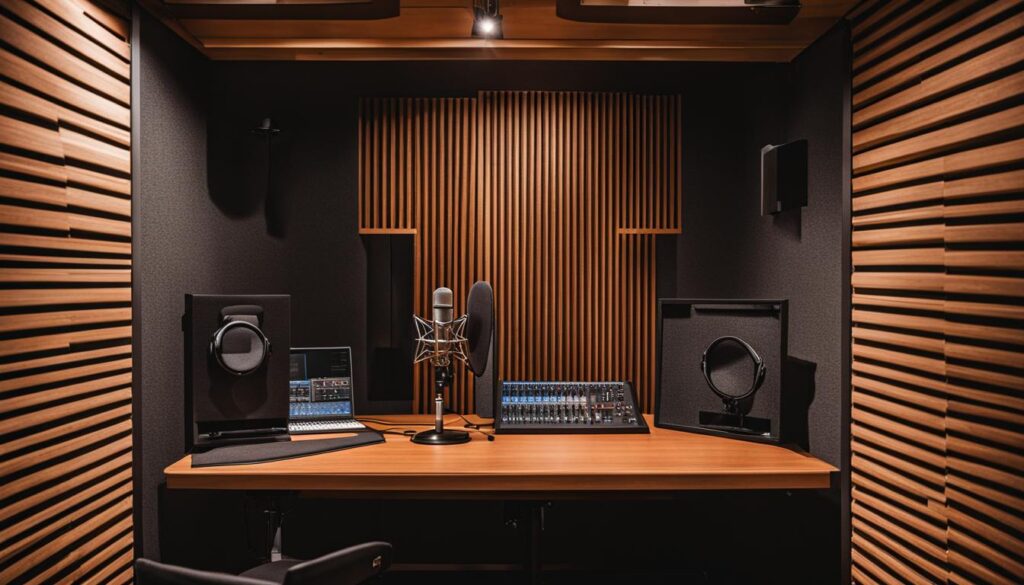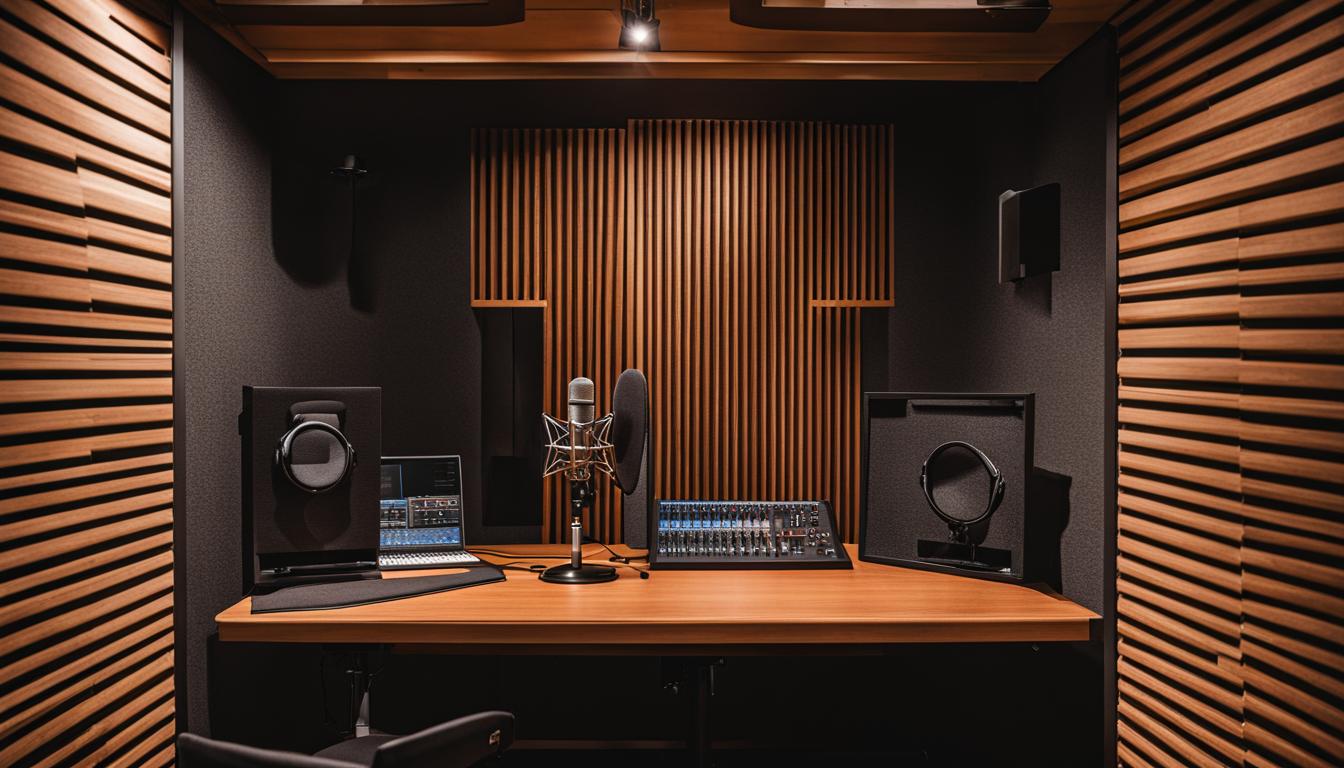As an audiobook narrator, having the right equipment is essential to create high-quality recordings that captivate and engage your listeners. In this article, I will introduce the must-have equipment that every audiobook narrator needs in their home studio.

Key Takeaways:
- Having the right equipment is key to creating engaging audiobook recordings.
- The most important piece of equipment is a high-quality microphone.
- Headphones are essential for monitoring your recordings accurately.
- Using a pop filter and windscreen can greatly improve the overall quality of your recordings.
- An audio interface is necessary for connecting your microphone to your computer.
- Proper acoustic treatment can help you achieve professional-sounding recordings.
Microphone
As an audiobook narrator, a high-quality microphone is the most important piece of equipment you will need to produce professional-sounding recordings. To ensure the best quality sound, look for a condenser microphone that provides a clear and crisp sound. USB microphones are a popular choice among audiobook narrators, as they are easy to set up and offer great sound quality without the need for additional equipment.
Investing in a good microphone is worth it, as it can greatly affect the overall quality of your recordings. A high-quality microphone can pick up subtle nuances in your voice, accentuate emotions and capture the essence of the story.
Brands like AKG, Shure, Neumann and Rode provide excellent quality microphones for audiobook narrators. It is important to test out various microphones and find one that best suits your voice and style.
Remember to always keep the microphone at a consistent distance from your mouth and avoid any movements that may create unwanted noise. Taking good care of your microphone by regularly cleaning and storing it properly will ensure it lasts for years.
Headphones
As an audiobook narrator, having good headphones is crucial for accurately monitoring recordings. Closed-back headphones are highly recommended as they minimize sound leakage and provide a more immersive experience. Make sure they are comfortable to wear for extended periods and provide accurate sound reproduction for capturing the subtle nuances of voice acting. Investing in high-quality headphones will significantly enhance the overall quality of your audiobook recordings.
To help you choose the best headphones for your needs, consider using headphones from trusted brands in the audio industry like Bose, Sennheiser, Audio-Technica, Sony, and Shure. These brands offer various headphones designed for studio recording, with features like noise-cancellation and detailed sound reproduction. By choosing the right headphones, you can make sure your recordings sound professional and engaging, every time.
Remember, selecting the right audiobook narrator equipment and using it properly is the key to producing high-quality recordings. Headphones are one of the essential pieces of equipment that every narrator should invest in. So, be sure to make an informed decision when purchasing your headphones and choose the best ones that suit your preferences and needs.
Pop Filter and Windscreen
Personally, I always use a pop filter and windscreen when recording audiobooks. These accessories are specifically designed to eliminate unwanted background noise and improve sound quality. A pop filter attached to the microphone helps reduce plosive sounds (such as “p” and “b” sounds) that can be distracting to listeners. On the other hand, a windscreen helps filter out unwanted background noise, such as breathing or sighing.
These are inexpensive but essential tools for any audiobook narrator, and they can greatly improve the overall quality of your recordings. When choosing a pop filter and windscreen, make sure they are compatible with your microphone and are made with high-quality material.
Pro Tip: Invest in a pop filter and windscreen. They might seem like small accessories, but they can make a world of difference in creating a professional-sounding audiobook.
Audio Interface
As I mentioned earlier, a good audio interface is a must-have for audiobook narrators. This device serves as the bridge between your microphone and computer, allowing you to record your voice with high quality. By converting the analog signal from your microphone to a digital signal that can be recorded on your computer, the audio interface ensures that your recordings sound clear and accurate.
When choosing an audio interface, look for models that have high-quality preamps, which will help boost the signal from your microphone. Low-latency performance is also important, as it minimizes the delay between when you speak and when you hear your voice in your headphones. This is especially important if you plan on recording multiple tracks simultaneously.
One of my favorite audio interfaces for audiobook narrators is the Focusrite Scarlett Solo (2nd Gen). It is affordable, easy to use, and delivers high-quality recordings. Other popular options include the Audient iD4 and the PreSonus Studio 24C.
Investing in a good audio interface can make a big difference in the quality of your audiobook recordings. So make sure to do your research and choose a device that meets your needs and budget.
Acoustic Treatment
As an audiobook narrator, creating a dedicated recording space is one of the most important investments you can make. The right acoustic treatment can make the difference between poor sound quality and a professional-sounding recording.
Acoustic treatment is all about creating a soundproof and acoustically balanced recording environment. This means reducing unwanted sound reflections and background noise while also ensuring that the sound you do capture is clear and accurate.
One of the best ways to achieve this is by using acoustic panels or foam to absorb echoes. These can be placed on the walls and ceiling of your recording space to minimize sound reflections and create a more controlled recording environment.
Another option is to invest in a microphone isolation shield, which can further improve sound quality by minimizing the amount of ambient noise captured by your microphone.
When choosing acoustic treatment for your recording space, it’s important to consider not only the quality of the materials but also their placement and configuration. Experimentation may be necessary to find the optimal setup for your particular space.
With the right acoustic treatment, you can create a space that helps you achieve the high-quality recordings that are essential for success as an audiobook narrator.
By prioritizing acoustic treatment, along with other essential equipment like a high-quality microphone and headphones, you can take your audiobook recordings to the next level.
